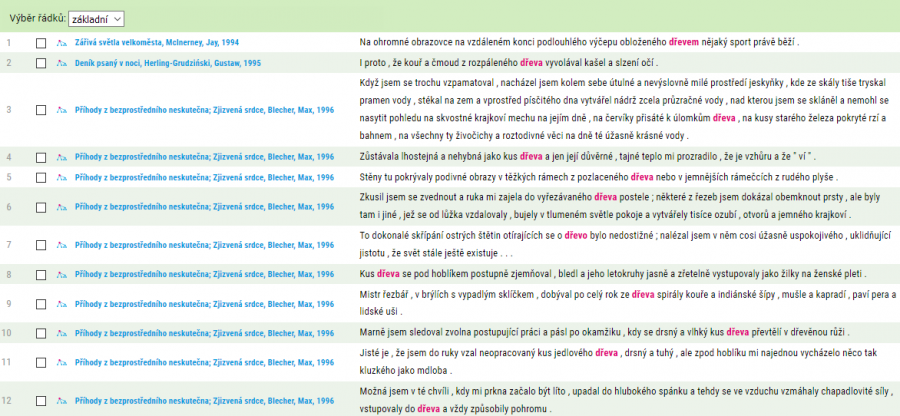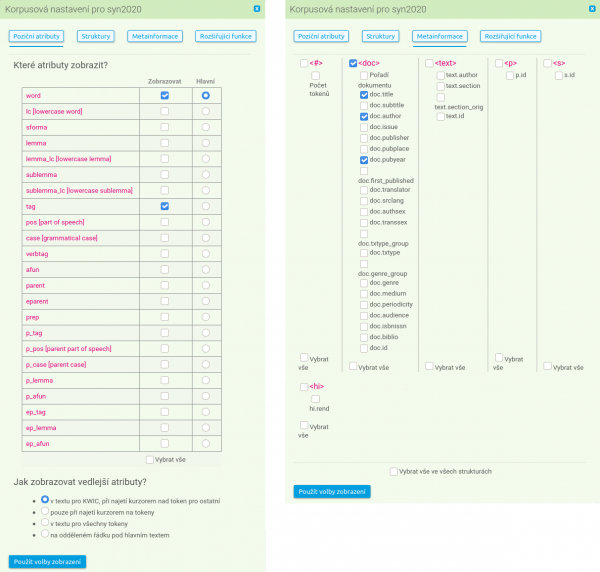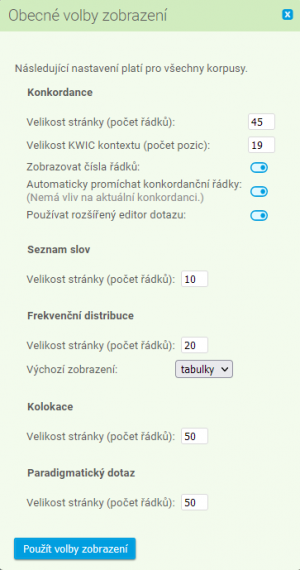This is an old revision of the document!
Table of Contents
Menu: View
Within this section of the menu interface KonText there are placed all of the options for altering the design and appearance of individual results of the search. The first two menu options (KWIC/Sentence and Attributes, structures a metainformation) modify the options for view which are specific for particular corpus, the last option (General view options) can be applied to all of the searches (regardless of the selected corpus).
KWIC/Sentence
The option KWIC/Sentence can be used to quickly switch from the concordance view which is centered around the red-coloured key word in the context (KWIC) to the view in which each concordance line contains the whole sentence in which the wanted phenomenon occurs.
Attributes, structures a metainformation
The form which appears after selecting the option View → Attributes, structures and metainformation contains a number of sections intended for setting various values. All of the options are both immediately applied to the most recent concordance and saved as the default value for every subsequent search in a given corpus.
Attributes
This option enables us to set the positional attributes which will be displayed in the concordance (the list can vary according to the corpus used, e.g. the corpora ORAL2006 or ORAL2008 are neither lemmatized nor morphologically marked). By default the attribute word is always switched on. In addition it is also possible to display one or more additional attributes (lemma, tag). Additional attributes are displayed behind the slash either by the searched word (KWIC) only, or by all of the context words (token) in the concordance.
Structures
Depending on what kind of the structural units does the given corpus contain, it is possible to switch on displaying of the beginning and the end of these structures directly in the concordance. They appear as figures in the angle brackets, e.g.
a krbových kamen <s> Komu již po zimě došlo dřevo, může zkusit tzv. " krblena " . </s> " Krblena " jsou velmi
For selection of more items from the list it is necessary to simultaneously use the mouse and press the Ctrl key (also for complete deselection).
Metainformace
Strukturní jednotky mají různé atributy (např. txtype) a hodnoty těchto atributů (např. NOV, SCI, POP) slouží k jejich klasifikaci a popisu. V konkordančním seznamu se tyto metainformace – vztahující se většinou k celému textu, z něhož daný konkordanční řádek pochází (např. autor, název apod.) – zobrazují vlevo, modrou barvou. Druh této informace a její rozsah je možné nastavit výběrem hodnot z nabídky Metainformace.
Úplnou informaci o všech strukturních atributech a hodnotách blíže určujících daný text je možné zobrazit kliknutím na příslušný modrý referenční údaj u libovolného konkordančního řádku. Údaj se zobrazí ve spodní části obrazovky.
Obecné volby zobrazení konkordance
Oproti předchozím nastvením volby, které skrývá formulář Možnosti zobrazeni → Obecné volby zobrazení konkordance, se aplikují na všechna hledání v libovolném korpusu. Jde především o rozsah a podobu konkordance, případně o její setřídění/promíchání.
Velikost stránky (počet řádků) - udává počet konkordančních řádků na stránce (nastavení příliš vysoké hodnoty může zpomalit zobrazování výsledků).
Velikost KWIC kontextu (počet pozic) - ovlivňuje rozsah zobrazeného kontextu v okolí klíčového slova v počtu pozic na obě strany (příliš rozsáhlý kontext je většinou kontraproduktivní, protože snižuje přehlednost konkordance; širší kontext je navíc možné vždy zobrazit kliknutím na KWIC).
Seznam slov - Velikost stránky (počet řádků) - udává počet řádků zobrazeného seznamu slov.
Frekvenční distribuce - Velikost stránky (počet řádků) - udává počet řádků zobrazené frekvenční distribuce.
Kolokace - Velikost stránky (počet řádků) - udává počet řádků zobrazeného výpisu kolokací.
Automaticky promíchat konkordanční řádky - aplikuje funkci Promíchat automaticky na libovolné hledání; nemáte-li specifické požadavky, doporučujeme tuto funkci nechat zapnutou. Zapnutí funkce nemá vliv na aktuální konkrodanci.










